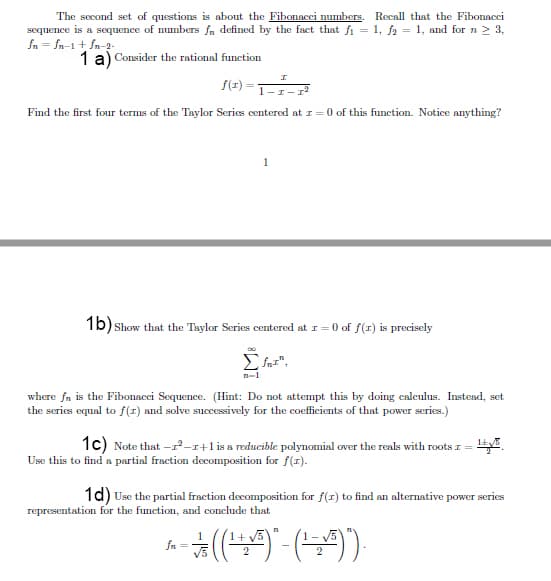The second set of questions is about the Fibonacci numbers. Recall that the Fibonacci sequence is a sequence of numbers fn defined by the fact that fi = 1, fa = 1, and for n 2 3, fn = fn-1 + fn-2- 1 a) Consider the rational function Find the first four terms of the Taylor Series centered at r = 0 of this function. Notice anything? 1 1b) Show that the Taylor Series centered at r= 0 of f(r) is precisely n-1 where fn is the Fibonacci Sequence. (Hint: Do not attempt this by doing calculus. Instead, set the series equal to f(1) and solve successively for the coefficients of that power series.) 1c) Note that -r-r+1 is a reducible polynomial over the reals with roots r= A. Use this to find a partial fraction decomposition for f(1). 1d) Use the partial fraction decomposition for f(r) to find an alternative power series representation for the function, and conclude that fn
The second set of questions is about the Fibonacci numbers. Recall that the Fibonacci sequence is a sequence of numbers fn defined by the fact that fi = 1, fa = 1, and for n 2 3, fn = fn-1 + fn-2- 1 a) Consider the rational function Find the first four terms of the Taylor Series centered at r = 0 of this function. Notice anything? 1 1b) Show that the Taylor Series centered at r= 0 of f(r) is precisely n-1 where fn is the Fibonacci Sequence. (Hint: Do not attempt this by doing calculus. Instead, set the series equal to f(1) and solve successively for the coefficients of that power series.) 1c) Note that -r-r+1 is a reducible polynomial over the reals with roots r= A. Use this to find a partial fraction decomposition for f(1). 1d) Use the partial fraction decomposition for f(r) to find an alternative power series representation for the function, and conclude that fn
Algebra & Trigonometry with Analytic Geometry
13th Edition
ISBN:9781133382119
Author:Swokowski
Publisher:Swokowski
Chapter10: Sequences, Series, And Probability
Section10.1: Infinite Sequences And Summation Notation
Problem 73E
Related questions
Question

Transcribed Image Text:The second set of questions is about the Fibonacci numbers. Recall that the Fibonacci
sequence is a sequence of numbers fn defined by the fact that fi = 1, fa = 1, and for n 2 3,
fn = fn-1 + fn-2-
1 a) Consider the rational function
f(1) =
Find the first four terms of the Taylor Series centered at r = 0 of this function. Notice anything?
1
1b) Show that the Taylor Series centered at I= 0 of f(r) is precisely
Σ.
n-1
where fn is the Fibonacci Sequence. (Hint: Do not attempt this by doing calculus. Instead, set
the series equal to f(1) and solve successively for the coefficients of that power series.)
1c) Note that -r-r+1 is a reducible polynomial over the reals with roots r= .
Use this to find a partial fraction decomposition for f(1).
1d) Use the partial fraction decomposition for f(r) to find an alternative power series
representation for the function, and conclude that
fn
Expert Solution
This question has been solved!
Explore an expertly crafted, step-by-step solution for a thorough understanding of key concepts.
Step by step
Solved in 4 steps with 4 images

Knowledge Booster
Learn more about
Need a deep-dive on the concept behind this application? Look no further. Learn more about this topic, advanced-math and related others by exploring similar questions and additional content below.Recommended textbooks for you

Algebra & Trigonometry with Analytic Geometry
Algebra
ISBN:
9781133382119
Author:
Swokowski
Publisher:
Cengage

Algebra & Trigonometry with Analytic Geometry
Algebra
ISBN:
9781133382119
Author:
Swokowski
Publisher:
Cengage